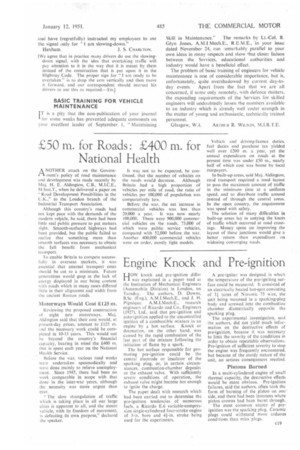in. for Roads: S:400 m. for National Health
Page 57

If you've noticed an error in this article please click here to report it so we can fix it.
A NQTHER attack on the GovernrAment's policy of road maintenance and development was made recently by Maj. H. E. Aldington, C.B., M.I.C.E., Minst.T., when he delivered a paper on -Road Development Possibilities in the U.K.," to the London branch of the Industrial Transport Association.
Although this country's roads had not kept pace with the demands of the modern velicle, he said, there had been little teal public pressure to put matters right. Smooth-surfaced highways had been provided, but the public failed to realize that something more than smooth surfaces was necessary. to obtain the full benefit from mechanical ransport.
To enable Britain to compete successfully in overseas markets, it was essential that internal transport costs should be cut to a minimum. Future generations would gasp at the lack of energy displayed in our being content with roads which in many eases differed little in their alignment and width from the ancient Roman roads.
Motorways Would Cost 2,125 m.
Reviewing the proposed construction of eight new motorways, Maj. Aldington said that their cost would, at present-day prices, amount to £125 in. Lnd the necessary work could be completed in 10-15 years. This would not be beyond the country's financial capacity, bearing in mind the £400 in. that is spent each year on the National Health Service.
Before the war, various road works were undertaken spasmodically and were done mainly to relieve unemployment. Since 1945, there had been no work comparable in scope with that done in the inter-war years, although the necessity was more urgent than ever.
The slow strangulation of traffic which is taking place in all our large cities is apparent to all, and the motor vehicle, with its freedom of movement, is defeating its own purpose," declared the speaker. It war not to be expected, he continued, that the number. of vehicles on the roads would decrease. Although Britain had a high proportion of vehicles per mile of road, the ratio of vehicles per 100,000 of population was comparatively low.
Before the war, the net increase in commercial vehicles was less than
20,000 a year. It was now nearly 100,000. There were 900.000 commercial vehicles on the roads, 73,000 of which were public service vehicles, compared with 52,000 before the war. Another 400,000 commercial vehicles were on order, mostly light models.
Vehicle and driving-licence duties, fuel duties and purchase tax yielded well over £200 in. a year, yet the annual expenditure on roads at the present time was under £50 tn., nearly half of which cost was borne by local ratepayers.
In built-up areas, said Maj„.Nldington, road transport required a road layout to pass the maximum amount of traffic in the minimum time at a uniform speed, and to distribute traffic around instead of through the central areas. in the open country, the requirement was speed with safety.
The solution of many difficulties in built-up areas lay in untying the knots of traffic which occurred at road crossings. Money spent on improving the layout of these junctions would give a better return than expenditure on widening convergine, roads.




































































































